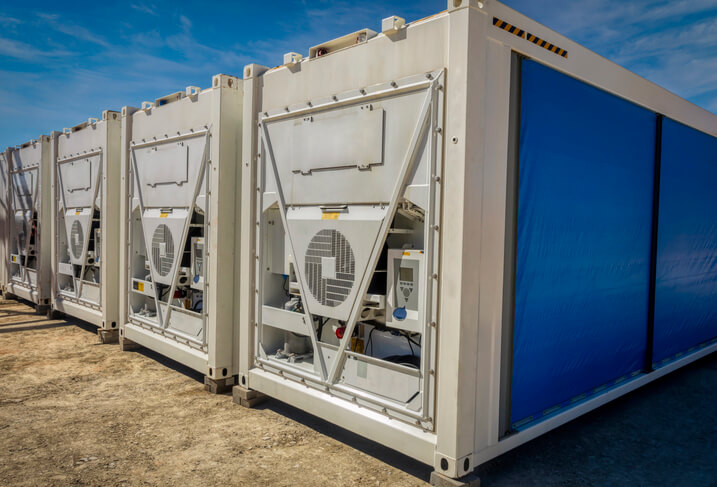23 Oct Why Proper Ventilation Matters for Storage Containers
When using shipping containers for storage, ventilation is necessary to keep your items safe and dry. Whether you’re storing personal belongings, construction tools, or business inventory, poor air circulation can lead to mold, rust, and heat damage. Luckily, there are plenty of options to keep the air flowing and your items in top shape. Does your situation call for extra ventilation? And if so, what goes into it? Find the answers here.
Do You Need Storage Container Ventilation?
Your storage container should come with two standard vents, which may be enough ventilation in some cases. Other times, increasing the airflow is highly recommended. Here’s what to consider before deciding.
Local Climate
Ventilation is essential if you’re using a shipping container in a hot setting like Phoenix, AZ, or a humid area like Dallas, TX. Hot, moist air trapped inside a sealed container can cause condensation, which leads to mold and rust. If you’re storing anything that could be damaged by too much heat or humidity, prioritize proper ventilation or even a fully climate-controlled storage container.
What You’re Storing
Ventilation becomes even more important depending on what’s inside the container. Are you storing paper files or canvas artwork? Mold is your enemy. How about metal machinery or tools? Rust could be an issue. And electronic gear? It could be ruined by extreme temperatures and high humidity.
Storage Duration
Short-term storage shouldn’t require extra ventilation, but the longer you keep things locked away, the more likely you’ll face issues like condensation or musty odors. Containers used for several months or longer, especially over the summer, should have adequate ventilation.
What Goes Into Storage Container Ventilation?
Effective storage container moisture control involves more than just cutting a hole for a vent and calling it good. A bit of strategy is involved to ensure you get enough airflow.
Cross-Ventilation
One effective way to ventilate a storage container is to place vents at opposite ends, allowing air to flow through naturally. This setup, known as cross-ventilation, prevents air from becoming stagnant, which can lead to humidity pockets and, you guessed it, mold.
Vent Size and Placement
Vents should be sized and positioned to maximize airflow. Place a vent near the top to release hot air and another near ground level to let in cooler air from the outside. For the best results, add at least two vents for cross-ventilation, keeping in mind that 1 square foot of vent space is recommended per 150 square feet of floor area.
Type of Vents
Choosing the right vent is also important. For instance, passive vents allow natural airflow without mechanical assistance, which is adequate for many storage situations. However, active vents may be necessary in hotter, damper conditions.
Storage Container Ventilation Options
Now that you understand why and how you might need to ventilate a storage container, it’s time to consider your options.
Fixed Louvers
Fixed louvers are the simplest and most cost-effective way to promote air circulation and prevent mold in storage containers. These vents allow air in while keeping rain and debris out for straightforward ventilation. Made of steel or similar durable materials, louvers are a long-lasting solution requiring minimal maintenance. They are most effective for housing items that aren’t temperature-sensitive in relatively mild climates.
Roof Turbines
Roof turbines are an electricity-free option that reduces heat and humidity levels more effectively than ordinary fixed louvers. They use wind energy to pull hot, humid air out of the container. As wind turns the turbine, the air inside the container gets sucked out, a handy feature in consistently windy areas.
Exhaust Fans
For containers located in hot, humid environments, an exhaust fan may be your best bet. This form of active ventilation pushes out stale air and pulls in fresh air from outside, providing consistent airflow even when the wind stops blowing. You can power exhaust fans with a regular outlet or a solar panel, allowing them to work well in different settings.
Air Conditioning
If you’re storing particularly delicate items or plan to use your storage container as a workspace, air conditioning may be a worthwhile investment. AC controls the temperature and removes humidity, reducing the risk of mold and rust. Keep in mind that AC units require a dependable power source; solar panels may not be consistent enough. And while they provide excellent climate control, air conditioners come with a higher installation and operating cost than the other solutions on this list.
Air conditioning works best if you also install insulation in your storage unit. Spray foam insulation is the most sensible for storage containers because it offers a high R-value and acts as a moisture barrier. It’s also more fire-resistant than other insulation options for your peace of mind.
Customize Your Storage Container with Ventilation Solutions
Proper ventilation is clearly a crucial factor in protecting your stored items from heat, moisture, and mold. At Pro Box Portable Storage, we rent and sell shipping containers in various sizes and styles, all of which come with two standard vents. If you determine that this is insufficient for your needs, you can always customize your storage container with roof turbines, exhaust fans, or air conditioning.
The containers from Pro Box Portable Storage feature super strong, 16-gauge steel construction and a seriously secure locking system to keep your goods safe. Plus, we offer 100% transparent pricing with no hidden fees. If you’re in Arizona, Colorado, Oklahoma, or Texas, contact us today for a free quote! We guarantee you’ll be satisfied with your purchase.




James
Posted at 13:22h, 19 MarchGreat writeup, keep up the good work!